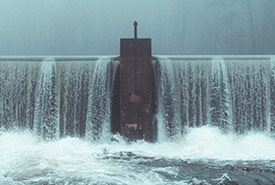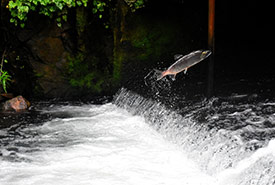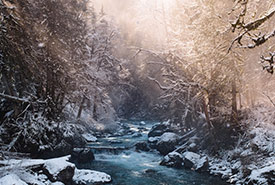How human-made dams impact rivers

Dam (Photo by Austin Evans, Unsplash)
As the lifeblood of the planet, rivers are teeming with biodiversity. They support a wealth of wildlife and provide many benefits to humans. In Canada, we have over 8,500 named rivers, according to WWF-Canada, and are home to 20 per cent of the world’s freshwater resources. The Mackenzie River is the longest river system in our country. Running through the Canadian boreal forest, it spans 4,241 kilometres and feeds over 50,000 lakes.
Related content

Fish jumping over a cascading river (Photo by Drew Farwell, Unsplash)
When healthy, rivers provide many critical ecosystem services that support humans and wildlife. They are vital habitat for freshwater fish, which are an important food source across the world. They also pick up sediment (rocks, sand and other solid materials) along the way and transport it downstream. As the sediment is deposited along river flood plains, it makes these areas fertile and builds levees, which are important barriers for extreme flooding. Sediment delivered by rivers also ensures that deltas remain above rising seas.
The impact of dams
Despite their importance, just a third of the world’s 246 longest rivers remain free flowing. A team of researchers from McGill University, World Wildlife Fund and several other institutions discovered this finding while conducting a global assessment of rivers.

A stream with snow-covered banks (Photo by Shayd Johnson, Unsplash)
The reason for this fragmentation is human-built dams and reservoirs. These physical barriers can impact the seasonal flow of rivers, trap sediment and also block the migratory paths of fishes and other wildlife — an issue that is highlighted in the National Environmental Treasure’s Biodiversity Action Agenda. They can even transform a river’s ecosystem from “cold, flowing and connected, to one that’s warm, stagnant and fragmented,” according to The Guardian.
Since 1970, wildlife populations in freshwater ecosystems have plunged by an average of 83 per cent. This is largely due to pollution, overuse and, most notably, dams. Disney’s latest blockbuster, Frozen 2, even addresses the negative impact that dams can have on the environment.
The global fight against climate change is centred on reducing the burning of fossil fuels and transitioning toward renewable energy. This shift is accelerating demand for low-carbon hydropower, such as dams. However, the environmental costs of these projects are often overlooked. Currently, there are a total of 60,000 large dams worldwide, with 3,700 in the planning and construction phases. While rising temperatures and changing land use in watersheds have already impacted river biodiversity, this shift toward dams could degrade them further.
Solutions
Solutions, however, shouldn’t hinge on the elimination of development, according to a lead author from the study. Rather, it’s all about finding sustainable steps forward that foster the co-existence between humans and free-flowing rivers.
Improving dam operations and finding more suitable locations that consider environmental impact are important measures. Shifting toward solar and wind projects can also be viable and sustainable alternatives. However, global cooperation and action are important as well. And the good news is that the international community has committed to “protecting and restoring” rivers as outlined in item 6.6 in the 2030 Agenda for Sustainable Development. In Canada, many smaller dams and barriers can be mitigated or removed relatively easily, using tools like the Freshwater Conservation Blueprint, developed by the Nature Conservancy of Canada’s Atlantic Region.
This post originally appeared on the National Environmental Treasure’s website and is reposted with permission.


